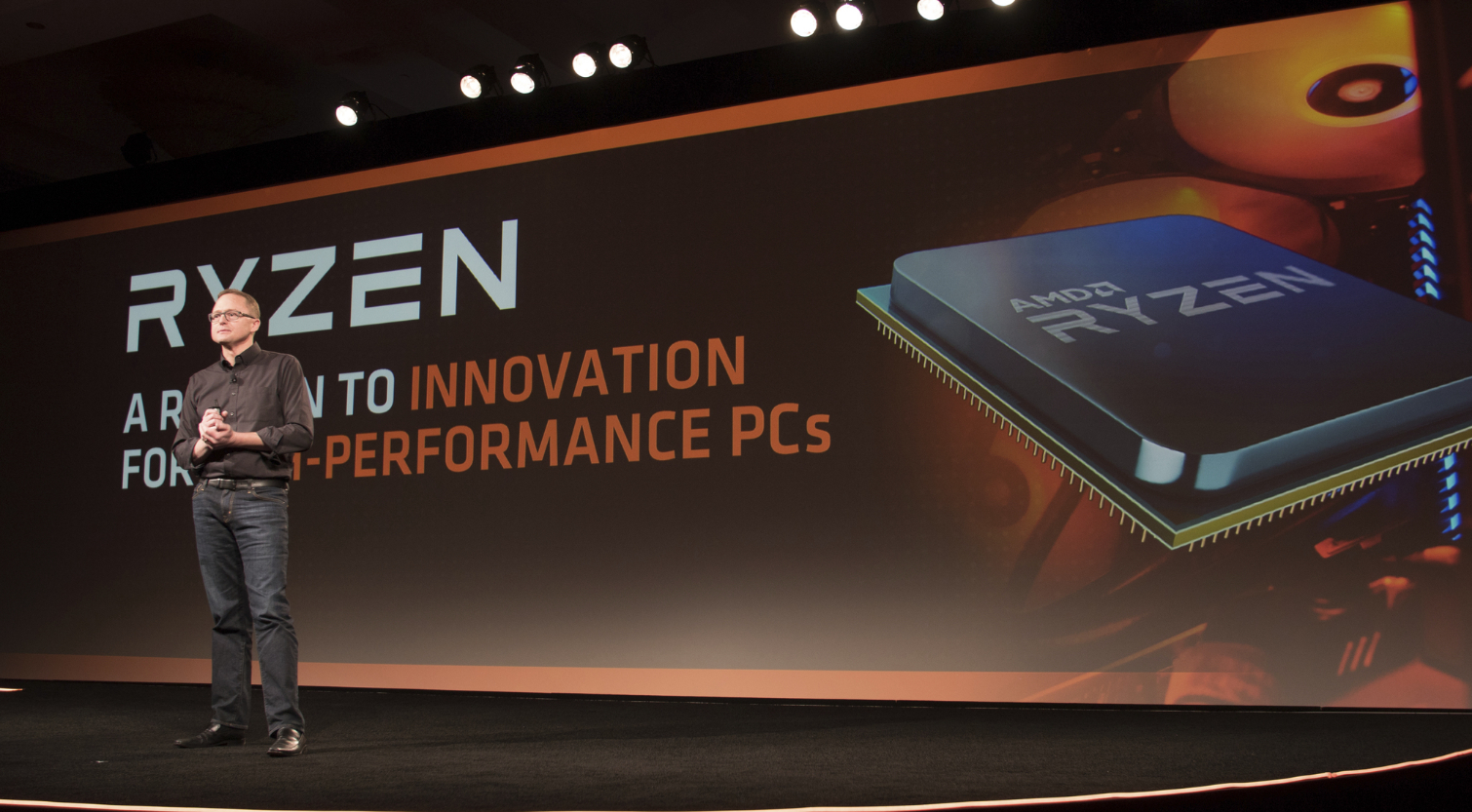AMD’s New Desktop Processors for 2018: What You Need to Know
AMD is bringing out a series of new Ryzen chips for desktop, including a pair of affordable processors with integrated Radeon graphics.
AMD has traditionally delivered value in its line of processors, so it sent a bit of a ripple through the industry when its first CPUs based on its latest “Zen” microarchitecture, in the new Ryzen line, started off on the upper end of the performance (and price) scale. Before long, Ryzen chips were already trickling into the mainstream and entry-level markets, helping AMD regain a foothold in the territory Intel had been trying to wrest away from it for years. So it’s not really a surprise that, in announcing its next wave of processors, this is where AMD is starting. But it’s not where AMD is stopping.

These new releases, which AMD announced at its Tech Day event held on Saturday, January 6, just before the start of CES 2018, represent an opening salvo in a new battle: against Intel’s Core i3 line of lower-end processors. But AMD isn’t stopping there. Here’s what you need to know about the company’s new releases.
What’s new about the 2018 Ryzen desktop chips?
AMD’s 2018 releases will run the gamut of features and performance, balancing what the company has already decided works with some new innovations. Many of these will be implemented in the second generation of Ryzen chips, which AMD is calling Ryzen Desktop 2000.
These chips will include SenseMI technology improvements that optimize power consumption; dynamically boost CPU frequency depending on temperature, current, and load factors; and more. AMD also touts silicon improvements for cache and memory speed, and for latency. Ryzen Desktop 2000 CPUs will also use a 12nm production process instead of the 14nm process used when Ryzen first launched last year.
Are any desktop processors with integrated graphics on the horizon?
Yes. In 2018, AMD will release Ryzen 3 and Ryzen 5 processors with Radeon graphics, for use in consumer, commercial, workstation, and enterprise systems. At this time, however, AMD has announced no plans to use integrated graphics on its higher-end Ryzen 7 chips.
This makes sense, though—these chips are commonly used in enthusiast and gaming PCs, where there is the reasonable expectation that the target audience will instead prefer to use even more powerful, discrete graphics cards. (Chip models that sport Radeon graphics will be labeled with a “G,” so you can tell just by looking—such as the Ryzen 5 2400G.)
How much more powerful will these new chips be compared with the previous generation?
Judging by AMD’s estimates, it depends on what you’re doing and what applications you’re using. The biggest gains appear to come in multithreaded workloads across a range of AMD benchmark tests (using the CineBench rendering test, POVRay 3.7, 7-Zip, TrueCrypt 7.1a encryption software, PassMark 9, and the SiSoftware Sandra Arithmetic test). AMD even calls the multithreaded performance of its sub-$200 Ryzen chips “disruptive” when compared against similar Intel chips. Perhaps unsurprisingly, AMD also gushes about the chips’ graphics prowess.
Sign up to get the BEST of Tom's Guide direct to your inbox.
Get instant access to breaking news, the hottest reviews, great deals and helpful tips.
How good will the Radeon-equipped chips be for gaming?
That remains to be seen (and tested), of course, but if the reality lives up to AMD’s own estimates, pretty good. The company says the Ryzen 5 2400G will play games at full HD resolution at frame rates much better than you’d see from the Intel Core i5-8400, and the Ryzen 3 2200G will similarly tower over the Core i3-8100. Without knowing the system specs and detail settings used, this is difficult to validate, but AMD’s long-running graphics experience should provide a marked improvement in gaming on lower-cost machines.
How do the new chips’ specs compare to those of Intel’s chips?
The Ryzen 5 2400G is a four-core, eight-thread APU with a base clock of 3.6GHz and a boost clock of 3.9GHz; the Ryzen 3 2200G starts at 3.5GHz and boosts up to 3.7GHz, and has four cores and four threads. Intel doesn’t have any chips in its current generation that match these directly, as in many cases they have similar clock speeds but more cores and threads, and that makes a direct evaluation difficult. (Though it becomes easier if you step back to Intel’s previous 7th Generation Core line.) For that reason, it might be more effective to look at the cost of the chips (see below).
If I want to buy one of these new chips, will I need a new motherboard, too?
Not necessarily. A new AMD 400 Series motherboard (with the AM4) socket will be required if you want access to the full slate of features in the chips, such as the graphics. But all of the new processors will be compatible with any Socket AM4 motherboard you may already have, so it doesn’t have to be an impediment to your upgrade.
When will the new Ryzen chips be released?
The first chips, the Ryzen 5 2400G and Ryzen 5 2200G (both APUs with on-board graphics), should be available on February 12. Second-generation Ryzen CPUs on the 12nm production process will hit sometime around April. And in the second half of 2018, you’ll see the second-generation of Threadripper and Ryzen Pro chips.

How much will the new chips cost?
So far, we only have definitive pricing information for the APUs being released in February. The Ryzen 5 2400G has a list price of $169; the Ryzen 3 2200G is listed at $99. That puts the former chip on par with the Intel Core i3-8350K (four cores, four threads, 4GHz), which, as of December, is priced at $168.
As of this writing, Intel doesn’t have a direct competitor for the latter; the closest is the four-core-four-thread, 4-GHz Core i3-8100, currently priced at $117. The chips in the second-generation Ryzen, Ryzen Pro, and Threadripper lines to be released later this year will probably be priced comparably to the models they’re replacing, but we don’t have numbers yet. That raises another question.
Will the prices of any other desktop Ryzen chips be affected?
Yes; many current Ryzen-based chips will be dropping in price. The Threadripper 1900X gaming chip, with eight cores and 16 threads, for example, is moving from $549 to $449, and the Ryzen 7 1800X sees an even more dramatic drop: from $499 to $349. None of the other chips drops quite as much; the Ryzen 7 1700X, moving from $399 to $309, comes close, but overall, expect to see reductions mostly in the $30 range.
What can we expect next from AMD in terms of desktop processors?
At Tech Day, company representatives said that the design for the 7nm Zen 2 core is complete, and claimed that it “improves on Zen in multiple dimensions.” Given that they also said that Zen 3, the “7nm+” design to follow that one, is “on track” for 2020, it seems fair to assume that we will see Zen 2 next year around this time. No additional information was provided about these processors or their capabilities, however.
Matthew Murray is the head of testing for Future, coordinating and conducting product testing at Tom’s Guide and other Future publications. He has previously covered technology and performance arts for multiple publications, edited numerous books, and worked as a theatre critic for more than 16 years.

